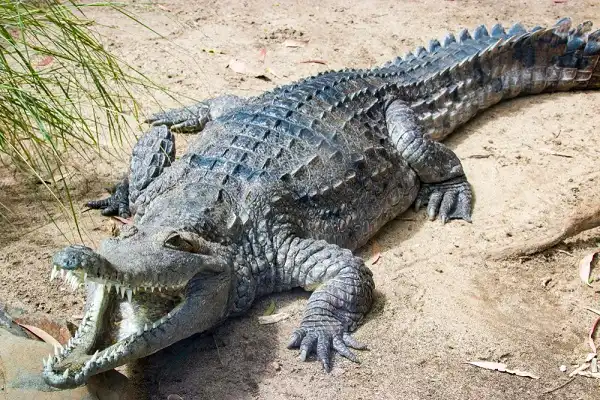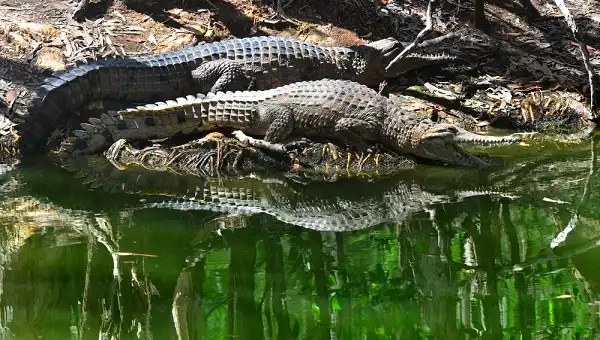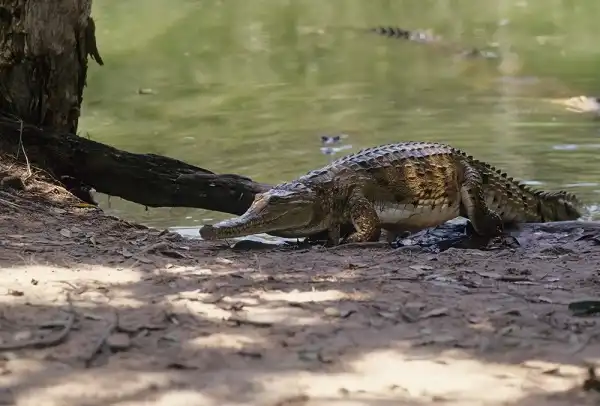Have you ever wondered how the powerful and ferocious freshwater crocodile, native to northern Australia, survives in one of the hottest places on earth? If so, this blog post is for you! Here, we’ll take a deep dive into freshwater crocodiles—from their habitats and behaviors to the threats they face and what it takes to live alongside them. We’ll also explore ways that humans can help protect this unique species from continued decline. So read on if you want to learn all about one of nature’s most majestic animals!

Freshwater Crocodile Description
The freshwater crocodile (Crocodylus johnsoni) is a species of crocodilian native to northern Australia. These impressive reptiles possess powerful tails, giving them the ability to swim quickly in their natural habitats. They are dark brown or olive in color, with lighter coloring on their underbelly. Their snouts are triangular-shaped and broad, with a single notch at the tip. Unfortunately for this species, human activity has caused a sharp decline in their populations over the past few decades. Development along waterways has led to habitat loss and fragmentation while pollution from agricultural runoff has polluted many estuaries where these animals live—leading to an overall decrease in numbers as well as reproductive health issues such as low fertility rates among both males and females.
Freshwater Crocodile Habitat
Freshwater crocodiles live primarily in rivers and wetlands of northern Australia’s tropical rainforest region. They build their homes near the water’s edge, usually in mud-bottomed pools or swamps and small creeks that are fed by running streams. The temperature of these habitats must stay within a certain range for them to survive—not too hot, not too cold. During monsoon seasons, they may move upstream into deeper waters as flooding occurs. Freshwater crocodiles are also known to take advantage of other aquatic habitats such as billabongs, swamps, lagoons, and marshes. Given their reliance on healthy habitats for survival, it is essential that we take steps to ensure freshwater crocodiles can continue living safely in northern Australia’s wetlands into the future.
Freshwater Crocodile Diet
The freshwater crocodile has an omnivorous diet, feeding on a variety of aquatic and terrestrial animals. Their staple diet consists of crustaceans such as crabs, shrimp, and crayfish; fish such as catfish, tilapia, perch, and eels; frogs; birds including waterfowl; small mammals such as rodents or possums; lizards and snakes. They also occasionally scavenge for dead animals. In addition to hunting animals for food, these reptiles will sometimes feed on plants—particularly when they are unable to find other sources of sustenance. The types of vegetation they consume include reeds, grasses, mangroves, root vegetables, and fruits. Such supplemental feeding helps keep their populations healthy and vibrant in habitats where food resources can be scarce.

Freshwater Crocodile Size
Freshwater crocodiles can reach lengths of up to 5.5 meters (18 feet) in adulthood, making them one of the largest freshwater reptiles in the world. As hatchlings, they measure only about 25 cm (10 inches) and grow at a rate of around 30 cm (12 inches) a year until they reach maturity. Adult males typically weigh between 75-100 kilograms (165-220 pounds), while females are usually much smaller at 25-45 kilograms (55-99 pounds). The stout body shape and powerful tail of the freshwater crocodile are an asset when it comes to propelling them through the water, enabling them to move quickly and efficiently. They also have webbed toes which help them maneuver even better in their aquatic environments.
Freshwater Crocodile Lifespan
Freshwater crocodiles have an average lifespan of around 30-50 years in the wild, although some individuals can live longer. In captivity, they are known to reach up to 70-80 years of age with proper care. These reptiles reach sexual maturity at around 5-7 years old but will continue to grow for several more years thereafter—growing larger and living longer as a result. As freshwater crocs age, their coloration tends to become lighter. They may also develop skin blemishes such as wrinkles and scaly patches due to age-related changes in the skin’s appearance. The oldest recorded captive freshwater crocodile was a female named “Jabiru” who lived in Australia at 81 years old! Other ancient specimens include males named “Willie” and “Smokey” who both lived into their 70s.
Freshwater Crocodile Behavior
Freshwater crocodiles are relatively shy and reclusive creatures, preferring to keep to themselves in their habitats. They will only become aggressive when threatened or provoked and can be very territorial towards other crocs, especially during the breeding season. When two males encounter one another they may engage in physical combat, using their powerful tails and sharp teeth as weapons. During the day freshwater crocodiles will bask on shorelines or partially submerged logs in order to warm up their bodies and regulate their internal temperature.
At night they move into rivers or wetlands to feed, often staying submerged for long periods of time while searching for food. These reptiles also use a process known as “thermoregulation” to maintain an optimal body temperature, which involves moving between sunny spots on land and cooler water environments. This behavior helps them survive the extreme temperatures of northern Australia’s tropical climate and ensures that they remain active year-round—particularly during the summer when waters can become incredibly hot.

Freshwater Crocodile Speed
Freshwater crocodiles have the ability to swim at speeds of up to 25 km/h (15 mph), making them one of the fastest freshwater reptiles in existence. While swimming, they use their powerful tails and webbed toes for propulsion, enabling them to weave through the water with great agility and speed. When on land, however, these reptiles move much slower; usually opting for a slow-moving “belly crawl” when necessary. In this type of locomotion, they pull themselves forward using their arms while supporting their bodies with their bellies—typically reaching speeds of around 1-2 km/h (0.6-1.2 mph). The speed of freshwater crocodiles can vary drastically depending on the environment they are in as well as the distance they need to traverse. For instance, if they are in an area with strong currents or rough water they may only be able to muster about 10 km/h (6 mph), whereas if the surroundings are calm and there is no resistance from obstacles such as vegetation then they can reach their full potential, reaching speeds upwards of 25 km/h (15 mph).
Freshwater Crocodile Reproduction
Freshwater crocodiles reach sexual maturity at around 5-7 years of age and begin to breed during the wet season, which typically takes place between April and October. During this time, male crocodiles will compete for mates by displaying aggressive behaviors such as vocalizations and physical combat with other males. Females then select a mate based on their size and strength, with larger males usually having an advantage. Once a pair is successfully formed, the female will lay her eggs in a nest that she has built up using mud and vegetation. The number of eggs can range from 10-50, depending on the size of the female.
These eggs then incubate for anywhere between 70-90 days before hatching. Unlike saltwater crocodiles, which show parental care for their offspring, freshwater crocs are much more independent when it comes to raising their young; leaving them alone after they have been laid in the nest to fend for themselves. Juveniles emerge from their shells as tiny versions of adult crocs—equipped with sharp teeth and powerful tails—and quickly disperse into nearby rivers or wetlands in search of food.
Freshwater Crocodile Hunting
Freshwater crocodiles are adept hunters and use a variety of techniques to capture their prey. They usually lie in wait for unsuspecting animals such as fish, turtles, snakes, birds, and small mammals to come close enough before pouncing upon them swiftly with powerful jaws. They also have keen senses that help them locate their prey from far away—using their keen eyesight to spot movement in the water and their highly sensitive internal organs to detect vibrations caused by nearby animals. When hunting in shallow water, freshwater crocs will often “surface strike” — propelling themselves out of the water with great speed and power in order to catch their prey off guard.
This technique allows them to quickly snatch up smaller animals like birds or rodents which may be too swift for them otherwise. Additionally, they also employ a unique behavior known as “death roll” when attempting to capture larger prey. This involves spinning around rapidly in the water while gripping onto its target with powerful jaws, causing it to drown or exhaust itself before it can escape. Freshwater crocodiles are also capable ambush predators and will use vegetation on the shoreline or partially submerged logs as cover in order to surprise their victims before attacking. Finally, they can hunt cooperatively by driving schools of fish into shallow waters where they can then feast together.

Conclusion
Freshwater crocodiles are fascinating creatures that have many interesting attributes and adaptations, allowing them to survive in the unique environment of Australia’s northern rainforest. Their extraordinary speed and agility when swimming through water make them excellent hunters and predators, while their reproductive behaviors ensure a continued presence in local waterways. Furthermore, they possess an array of protective mechanisms against potential dangers—making them well-adapted for life in northern Australia’s tropical rainforest region! Overall, freshwater crocs are remarkable reptiles that have been around for millions of years; showcasing just how successful these animals can be when living in harmony with their environment!
Frequently Asked Question


